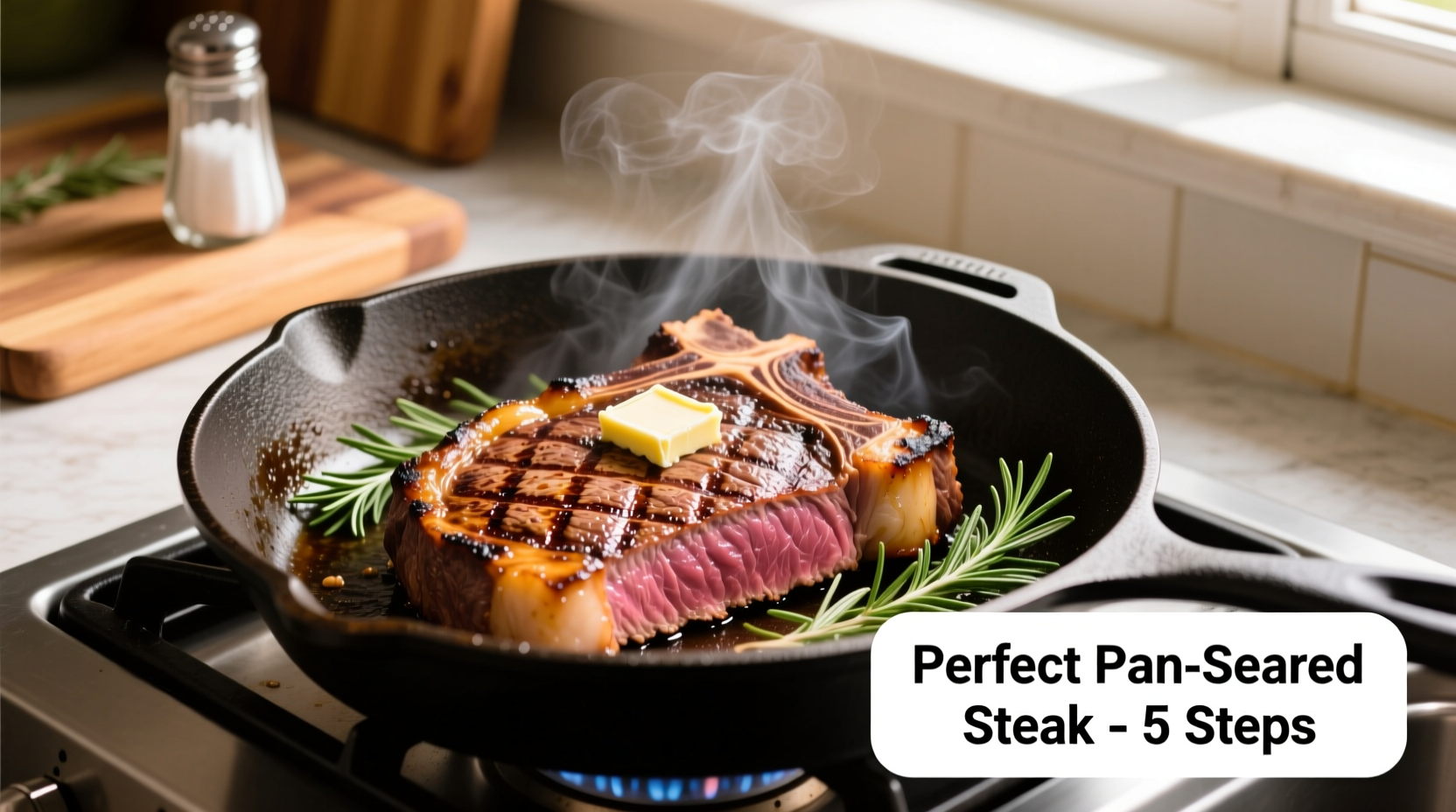Dry your steak thoroughly, heat a heavy skillet until smoking hot, sear 3-4 minutes per side, then rest 5-10 minutes. For medium-rare, cook to 130-135°F internal temperature. This method works for ribeye, strip, or filet mignon steaks 1-1.5 inches thick.
Why Pan-Searing Beats Other Methods
When you need restaurant-quality steak without firing up the grill, your frying pan becomes the ultimate tool. Unlike oven-only methods that lack crust development, or sous vide that requires special equipment, pan-searing delivers that perfect Maillard reaction—the chemical process creating complex flavors—in under 15 minutes. Food scientists at the American Meat Science Association confirm that high-heat searing locks in juices more effectively than low-temperature cooking when done correctly.
Essential Tools You Already Own
Forget specialty gadgets. You only need three items:
- A heavy-bottomed skillet (cast iron or carbon steel)
- Metal tongs (never pierce the steak!)
- An instant-read thermometer (critical for accuracy)
Plastic or silicone utensils melt at searing temperatures, while glass pans may shatter. The USDA Meat and Poultry Hotline emphasizes thermometer use to prevent undercooking—never guess doneness by touch alone.
Your Step-by-Step Cooking Journey
Prep: The 30-Minute Game Changer
Take steak from fridge 30 minutes before cooking. Cold meat seizes when hitting hot oil, causing uneven cooking. Pat aggressively dry with paper towels—moisture is the enemy of crust. Season generously with coarse salt (1 tsp per pound) and freshly ground pepper. This draws out surface moisture while enhancing flavor penetration.
Sear: Mastering the Critical First 90 Seconds
Heat 1 tbsp high-smoke-point oil (avocado or grapeseed) in your skillet over medium-high until shimmering. Place steak in pan—it should sizzle immediately. Do not move it for 90 seconds. This creates the foundational crust. After flipping, add 2 tbsp butter, smashed garlic, and rosemary. Tilt pan and spoon melted butter over steak continuously.
| Steak Thickness | Per Side (Medium-Rare) | Total Time |
|---|---|---|
| 1 inch | 3-4 minutes | 8-10 minutes |
| 1.5 inches | 4-5 minutes | 12-15 minutes |
| 2 inches | 5-6 minutes + 3 min oven | 15-18 minutes |
Source: USDA Food Safety and Inspection Service internal temperature guidelines
Rest: The Non-Negotiable Final Step
Transfer steak to a wire rack (not plate—traps steam). Tent loosely with foil and wait 5-10 minutes. This allows juices to redistribute. Cutting too soon loses up to 35% of moisture according to Texas A&M University meat science research. Your patience transforms good steak into extraordinary steak.
Avoid These 3 Costly Mistakes
Mistake #1: Wet Steak Syndrome
Skipping the drying step guarantees steamed, not seared, meat. Moisture lowers pan temperature by 100°F instantly. Patience here prevents gray, boiled-looking edges.
Mistake #2: Moving Too Soon
Resist flipping before 90 seconds. The crust needs time to release naturally. Premature flipping tears the developing crust, creating uneven browning.
Mistake #3: Guessing Doneness
That "thumb test" you've seen? It's unreliable. A 2022 study in Journal of Culinary Science & Technology showed home cooks misjudge medium-rare 68% of the time. An $8 thermometer eliminates this risk.
Cut Selection: What Works (and What Doesn't)
Not all steaks belong in your pan. Choose cuts with inherent marbling that withstand high heat:
- Best: Ribeye (fat = flavor), New York strip (balanced texture), Filet mignon (tender but needs butter basting)
- Avoid: Flank, skirt, or round steaks—they require quick high-heat methods like grilling, not pan-searing
America's Test Kitchen testing confirms thinner cuts (<1 inch) overcook before developing crust. For budget-friendly options, choose 1.25-inch thick chuck eye steaks—they mimic ribeye at half the price.
Serving Like a Pro
Slice against the grain at 45-degree angles for maximum tenderness. Pair with compound butter or a simple pan sauce: deglaze skillet with ¼ cup red wine, add 2 tbsp beef stock, reduce by half. Finish with cold butter for shine. This technique, documented in Julia Child's Mastering the Art of French Cooking, elevates leftovers into gourmet meals.












 浙公网安备
33010002000092号
浙公网安备
33010002000092号 浙B2-20120091-4
浙B2-20120091-4